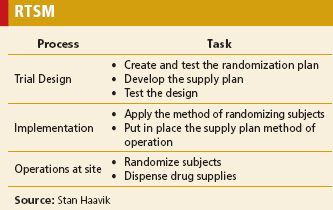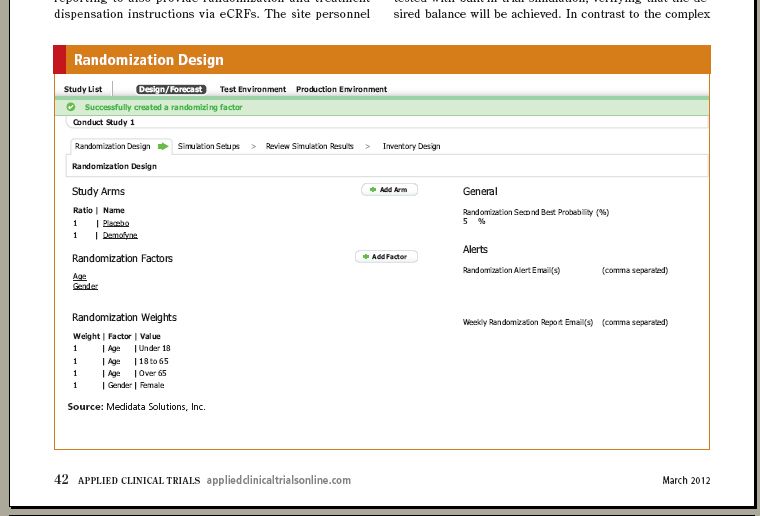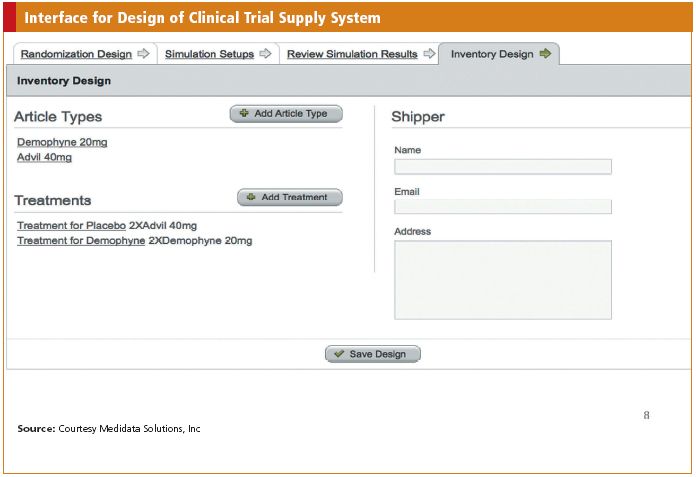Randomization Revolution is Brewing
Applied Clinical Trials
Systems that support automated processes have begun to transform the conduct of clinical trials.

In recent years the adoption of systems that support automated processes has begun to transform the conduct of clinical trials. The improvements signal a promising collaboration between the science of clinical research and the technology of automation.
Certainly for the past dozen years the growth of electronic data capture (EDC) is evidence of the successful application of technology to clinical trials. According to a Health Industry Insights report, EDC was in use in approximately 90% of Phase III trials in 2010.1 Total expenditures for EDC across all phases were estimated at $580 million in 2010. The same report states that the average adoption of EDC across all phases grew from 15% to 50% from 2003 to 2008. Other examples of processes that have been enhanced and automated through innovative technology include clinical trial budgeting, clinical trial management activities, clinical data management and processing, and site and patient recruitment.
Predating EDC, perhaps the earliest innovation was interactive voice response (IVR) systems applied to subject randomization and treatment dispensation. When introduced in the 1980s, this technology coordinated clinical research processes across dispersed sites and greatly contributed to improved management and conduct of clinical trials.
While IVR technology has been widely adopted and successful in partially automating randomization and trial supply management (RTSM), its implementation has some associated drawbacks chiefly due to the manual processes required. Once a design is developed and agreed, it must be converted to software requirements which are then transformed into specifications. From the specifications, the software code is developed and then tested. After this is completed the actual customer or user of the IVR system can see it in operation for the first time leading almost always to revisions and retesting. Once in operation, significant maintenance and support efforts are often required to keep everything running well. If a change to the trial is desired, the program must be revised and revalidated.
The newer implementations using web technology, known as interactive web response (IWR) systems, are also marked by a slow and expensive setup. However, as pointed out in a recent article, the ubiquity of the Internet and widespread availability of computers in clinical settings provide strong motivation for the use of IWR data entry over voice-prompt IVR technology.2 The user interface for the IWR offers the biggest advantage: seeing the data appear on a screen as it is being entered and thus confirming the entry visually. In the context of visual prompts and previous entries, this is perhaps the biggest advantage. Since interruption is a fact of life in clinical offices, the facility to drop the data entry task for a moment or two and come back later to the same point is another major benefit over IVR.
In other industries, also beginning in the 1980s, very exciting technological developments were taking place, spurred by the introduction of the personal computer (PC). In just a few years the PC became a versatile platform for the design of electronic, mechanical, and architectural products. Unlike the IVR technology that was the human interface for RTSM in the life sciences industry, the interface for the computer was the workstation screen. One of the new applications, computer-aided design (CAD), spurred innovation across multiple industries, which continues today.
This article reviews highlights of automation progress in industries affected by CAD and compares it to methods used for developing and applying RTSM for life sciences organizations. In the conclusion, a new paradigm for randomization, trial supply design, implementation, and operation is described that parallels the methods of computer-aided design used so effectively in other industries since the 1980s. This new approach for the life sciences sector offers efficiencies and economies long realized by other industries and long needed to improve the performance of clinical trials.
RTSM overview
The development of a randomization and trial supply management (logistics) system for a clinical trial involves three linked processes: creation of the randomization and logistics designs, implementation of the designs, and operation of the implemented system at sites (Table 1).

In the first process, critical decisions are made that affect the statistical reliability of the results, the quality and efficiency of the trial, and the operations related to the collection of data at the investigative site.
In the implementation process, the randomization and supply plan is put into operation with software code. Voice instructions are created that will be triggered by telephone key code entry by site personnel. Finally, in the operations phase, the tested and validated system is deployed in a clinical trial, and support and maintenance for the system is engaged.
Automation of design
As noted above, the use of IVR was first introduced in the 1980s and made it possible to efficiently randomize subjects spread across many sites, as well as guide the dispensation of treatments.
In other industries, different automation techniques were being introduced and evolved. Mentor Graphics, Inc., began operations in 1983 in Oregon and employed the new technical workstations to design electronic circuits. The use of the new workstations provided a quantum leap in performance over the first personal computers coming to the market, and certainly over earlier methods of drawings on paper and systems that digitized those drawings. Mentor now has revenues approaching $1 billion and continues as a leader in electronic computer-aided design (ECAD). Autodesk, Inc., a California company, began operations in 1982 with a focus on the design of mechanical and architectural products, or MCAD. Autodesk's revenues now approach $2 billion and it is the unquestioned leader in this field. The missions of these two companies (and their many competitors) were propelled by aggressively putting to work in ever more sophisticated ways the increasing computational power found in new generations of electronic "chips."
Workstations were characterized by sophisticated human-computer interaction driven by a visual display of information on the workstation screen. Product designers using applications from Mentor Graphics or Autodesk had at their disposal arrays of modular components and could employ and interconnect them in any way that made logical sense. It wasn't long before simulation techniques were introduced as well. With simulation, the designer could immediately test his design and verify correct operation of the circuitry or mechanical component without physically building the prototype.
There is a key and crucial difference in the way systems used in design and operation of RTSM were deployed in the pharmaceutical industry versus industries where CAD was the design tool. In the pharmaceutical industry, advanced tools and methods used to develop and program the RTSM deployments remained largely in the hands of service providers; those companies that sold, programmed, implemented, and maintained the systems. Over time this became a significant service business for many of the vendors and CROs. In CAD driven industries, the design tools were sold to the companies that were in the business of making the designed products, such as circuit boards, computers, mechanical parts, and assemblies. In the life sciences, the focus was on delivering professional services while in the other industries the focus was on the development of better tools sold for use by their customers.
In the case of the CAD industry, the CAD tool companies were driven by a fast tempo of demand from their customers, manufacturers of products requiring ever more sophisticated design tools. To this day, the mix of CAD vendors and their customers continues to be an ecosystem of tremendous drive and innovation.
Some might argue that the CAD business evolved as it did because it served a much bigger market, and that the designs were implemented in thousands or millions of manufactured products. Therefore the economics of the industry favored the CAD market because each successful design enabled the costs of design and manufacture to be spread over many instances of the same product. However, it should be recalled that the goal of clinical trials is the efficient and safe testing of new treatments that will, if effective, be reproduced in volume. The testing is preceded by a design for RTSM used to create the subsequent clinical trial. If the trial is successful, the sponsor's usual goal is the recovery of costs over many treatments or potentially millions of manufactured pills, highly analogous in principle to the CAD and manufacturing example. So even though the methods and results in radically different industries are being compared, the goals of each are ultimately quite similar.
The "randomization revolution" refers to a new model which introduces significant change to RTSM. The crux of this change is best described as the introduction of "self-service" capabilities. The new methods being introduced by several vendors simplify, speed, integrate, and lower the costs of RTSM. Even with the new self-service approach available, however, many sponsors will continue to employ service providers to benefit from their deep experience in the many complex aspects of randomization and supply logistics.
Designing the randomization
We now turn to tracing the processes and tasks first described in Table 1 and provide added motivation for the new methods of the randomization revolution. From Table 1, the first RTSM task is randomization and logistics design. Randomization methods include techniques such as simple randomization, akin to coin tossing, block randomization and dynamic allocation, which assigns patients to treatments during the trial based on patient characteristics and previous treatment assignments, and is also known as minimization for its ability to reduce subject imbalance between arms.
It has been reported that clinical trials are becoming more complex.3 To address the complexity, the methods of dynamic allocation would appear best suited. Dynamic allocation can more readily support trial designs required for the complex protocols often used in oncology trials and other therapeutic areas. Furthermore, the International Conference on Harmonization guidelines emphasize that randomization in a multicenter trial should be stratified by study sites. In supporting this requirement, some dynamic methods can specifically improve the overall site imbalance.4
While dynamic allocation methods have been used in many trials,5 they have not moved into more general use partly because of operational and implementation barriers. These include difficulties in applying and programming the complex underlying algorithms that perform the randomization.6 Because of its numerous potential benefits, we anticipate that dynamic methods would be increasingly favored if the obstacles to their implementation could be resolved. New computer technologies have now been applied that can achieve this goal.
A computer software method used to implement dynamic allocation as well as other randomization schemes is based on the use of configurable software. The software is pre-built, pre-tested, and pre-validated, and is configured when parameters are introduced to create an instance of the software. The parameters can be provided as input to the software by their entry in simple forms on a computer screen. Therefore no custom software is required to be built, and once configured the software is immediately ready for use.7 These capabilities avoid the lengthy and error-prone conventional software methods predominantly in use today.
Implementation of the design
The next phase of setting up the trial with today's methods requires the design plans to be translated (i.e., programmed) to software code that operates the IVR/IWR computer system. Today this is an expensive task taking weeks to months of manual translation of the RTSM design to a software specification, programming the software to meet the specification, and testing and validating the system by human operators. This phase of implementation is often a source of delay in the trial because software is difficult to design, produce, and test. Even disciplined processes are slow, often yielding unknown errors (bugs), and requiring extensive quality review and rework.8
We have seen with the CAD examples how the design can be visually created on a computer screen and tested with simulation methods to verify within seconds that the design will deliver the correct results. Once approved, the software code to implement the design is generated which will drive machines that will produce the design. Typically, the generated software code operates machines that cut and drill the printed circuit boards. For mechanical parts, the software code can drive a milling or cutting machine.
As discussed in the last section, instead of the lengthy and cumbersome methods now used to create IVR software, in the new "self-service" paradigm the software code is configured via the specification of parameters that completely describe to the software the correct operation. Much as the CAD system generates software to operate machinery, the configured software is immediately available to randomize patients when linked to an EDC system.
Operations at site
Trial operations begin with the selection of subjects through screening by site clinicians. Once selected, the subject's personal data is entered onto an electronic case report form (eCRF) in an electronic data capture (EDC) system or, in trials still using paper, on a paper case report form. The clinician then uses the IVR or IWR system to allocate the subject into a trial arm without bias, and, if the trial is single or double-blinded, without indicating the specific treatment to the patient, or the patient and clinician, respectively. The appropriate medication for the arm is dispensed according to separate instructions guiding the clinicians. Today's practice is marked by separate systems for receiving randomization/dispensation instructions, and for clinical data collection via EDC. However, integration of the IVR/IWR technology with EDC is gradually taking place to provide a preferable single user interface for all interaction by the site personnel. Many other benefits of integrating clinical trial technology are summarized in an article by Neil Warnock.9
The operations function in the electronic or mechanical industry corresponds to the manufacture of the circuit board or the mechanical part. Here plant personnel interact with the computer-driven machines verifying and managing their operation through status displays, providing feed stocks and intervening in the event of a tool malfunction.
As can be seen in the descriptions above, computer-driven systems in both industries provide information on next steps in their respective work processes and assist in processing their raw inputs, subjects, or materials.
In the new self-service model, operations at the site can be simplified for clinicians by the use of one browser interface for randomization, supply management, and EDC. Errors in software as well as user input errors that frequently plague today's IVR implementations will be minimized by the use of configured, pre-validated software.
Forward path
In the foregoing discussion the methods and development of the CAD tool industry have been contrasted with the innovation introduced as IVR in the 1980s. It now appears that the IVR industry is in the very early stages of a transformation into the use of methods characterizing the CAD industry since the 1980s. The hallmark of the change is the incorporation of "self-service" methods used by sponsors or service vendors.
In initiating the randomization revolution, four key innovations enable the self-service nature of the new paradigm:
A visual interface for interactive design of the trial.
Interactive, self-service design of the randomization and logistics plans.
Configurable software that serves as the core engine for randomization.
Unification of the RTSM and EDC system.
By providing a visual interface similar to CAD systems for the design of the randomization, the designer is presented with a holistic environment for randomization and supply planning. The new environments offer considerable design power to aid the decisions that the trial requires. An interface can be quite simple, requiring the entry of only a few parameters (Figure 1). Once the parameters are entered, the design is configured and available as software code that completely describes the trial's randomization.
Figure 1. An interface can be quite simple, requiring the entry of only a few parameters.

Similar to CAD methods, the design can be interactively reviewed and tested using a built-in trial simulator and the balance among arms, factors, and even sites can be verified. The statistician or other designer can know, within a few minutes, whether the design meets requirements for balance and power. Until recently, immediate and simple methods of testing the design for balance have not been available. Using the new tools, a balanced design with minimum bias can be verified prior to implementation.
In addition to randomization, the new visual interface may also incorporate a self-service, interactive means of designing the drug supply system. This interface asks for inputs that specify the article types and treatments (Figure 2). Additional screens take inputs for inventory levels of supplies, automatic re-ordering and messages to be sent to resupply points.
The interface asks for inputs that specify the article types and treatments

Besides the visual interface, interactivity, and self-service nature of the new methods, a significant additional advantage of an advanced RTSM system is that each instance of the system being used is pre-validated. The data input fields in the visual interface are fixed and the underlying software and algorithm remain unchanged from trial to trial. As discussed earlier, such software is called configurable, because as the inputs are supplied, the software is configured to represent the desired trial characteristics and operation. Because it is pre-built, pre-tested, and pre-validated, no additional testing is needed. If desired, site clinicians can run some "example patients" through the software to build confidence that results are as expected, without interfering with the actual allocation.
This advanced "self-service" RTSM system fully replaces IVR/IWR. Instead of the complex programming, testing and validation IVR/IWR systems require, the algorithms that govern instructions to the site have been coded as software once-only the input variables to the algorithms change. As a final step in implementation, the software that specifies the randomization and trial supply operation is linked with the EDC system. This enables the randomization and supply instructions to be presented to the site personnel via electronic case report forms.
In this way, the role of the EDC system already in place and familiar to site clinicians expands beyond clinical data reporting to also provide randomization and treatment dispensation instructions via eCRFs. The site personnel interact with only one source of instructions and data input, unlike the dual interactions often required today with separate systems for EDC and RTSM.
Since EDC represents a familiar system and interface to the site personnel, training in the new methodology is relatively easy, representing a simplification over current methods in which multiple vendors, multiple data reconciliations, and differing hardware and software systems often bring training and operating challenges.
Summary
A configurable, self-service paradigm, built on advanced computer software, has been described which offers significant improvements to current methodologies for designing, implementing, and operating RTSM systems. The new methods are analogous to the CAD developments that have fostered innovations in product design and manufacturing since the early 1980s. Some sponsors of clinical trials who have seen the simplicity of design and integration with EDC offered in the new types of systems verify that the new methods are long overdue.
The new RTSM system provides visually simplified application of a sophisticated statistical algorithm and a trial design in a short amount of time. The design can then be tested with built-in trial simulation, verifying that the desired balance will be achieved. In contrast to the complex programming required to set up an IVR or IWR, the code that provides randomization and supply instructions to the site clinical personnel is configured from the design input, not created as a custom project for each trial.
Finally, instructions are delivered to site personnel via EDC, the same means by which most currently report clinical data. The EDC interface is used at the site for RTSM as well as clinical data reporting, providing simplicity of operation, less need for training, fewer errors and delays, and lower system maintenance and support burden.
With this approach, new, improved methods are now available for randomizing, implementing, and operating clinical trials more simply and quickly than prevalent existing methods.
Stanley J. Haavik, MS, MBA, is Director, Product Marketing at Medidata Solutions, Inc., 79 Fifth Avenue, 8th Floor, New York, NY, e-mail: shaavik@mdsol.com
References
1. A. S. Louie and C. Connor, "Health Industry Insights, Business Strategy: US Electronic Data Capture, 2008–2014 Spending Forecast and Analysis," IDC Health Insights, February 2010, http://www.idc-hi.com/getdoc.jsp?containerId=HI221735/.
2. W. Kubick, "I'm Very Reluctant to Use IVR," Applied Clinical Trials Online, March 18, 2011, http://blog.appliedclinicaltrialsonline.com/2011/03/18/i'm-very-reluctant-to-use-ivr/.
3. K. Getz, "Tufts University CSDD Impact Report," May/June 2010.
4. International Conference on Harmonization, "E9: Statistical Principles for Clinical Trials," IFPMA (1998).
5. G. R. Pond, et al., "Trends in the Application of Dynamic Allocation Methods in Multi-Arm Cancer Clinical Trials," Clinical Trials, 7 (3) 227-234 (2010).
6. R. Peto, M. C. Pike, P. Armitage, et al., "Design and Analysis of Randomized Clinical Trials Requiring Prolonged Observations of Each Patient: I. Introduction and Design," Br J Cancer, 34 (6) 585-612 (1976).
7. S. Haavik, "Bringing Process Efficiency to Clinical Trial Randomization," Pharmavoice, 64, (June 2011).
8. M. Downs, et al., "Some Practical Problems in Implementing Randomization," Clinical Trials, 7 (3) 235-245 (2010).
9. N. Warnock, "The Benefits of Using Integrated Technology with Clinical Trials," Life Science Leader, 40-41 (July 2011).

Improving Relationships and Diversifying the Site Selection Process
April 17th 2025In this episode of the Applied Clinical Trials Podcast, Liz Beatty, co-founder and chief strategy officer, Inato, discusses a number of topics around site engagement including community-based sites, the role of technology in improving site/sponsor relationships, how increased operational costs are impacting the industry, and more.
Behind the Buzz: Why Clinical Research Leaders Flock to SCOPE Summit
February 7th 2025In this episode, we meet with Micah Lieberman, Executive Conference Director for SCOPE Summit (Summit for Clinical Ops Executives) at Cambridge Innovation Institute. We will dive deep into the critical role of collaboration within the clinical research ecosystem. How do we bring together diverse stakeholders—sponsors, CROs, clinical trial tech innovators, suppliers, patients, sites, advocacy organizations, investors, and non-profits—to share best practices in trial design, program planning, innovation, and clinical operations? We’ll explore why it’s vital for thought leaders to step beyond their own organizations and learn from others, exchanging ideas that drive advancements in clinical research. Additionally, we’ll discuss the pivotal role of scientific conferences like SCOPE Summit in fostering these essential connections and collaborations, helping shape the future of clinical trials. Join us as we uncover how collective wisdom and cross-industry partnerships are transforming the landscape of clinical research.